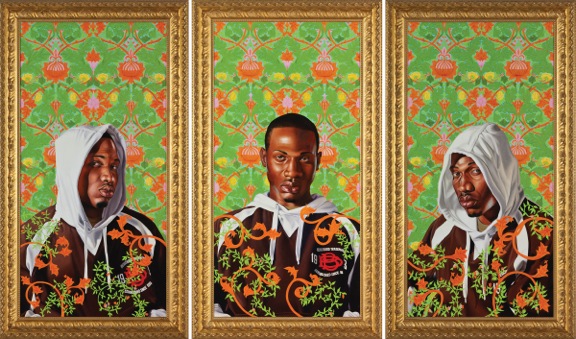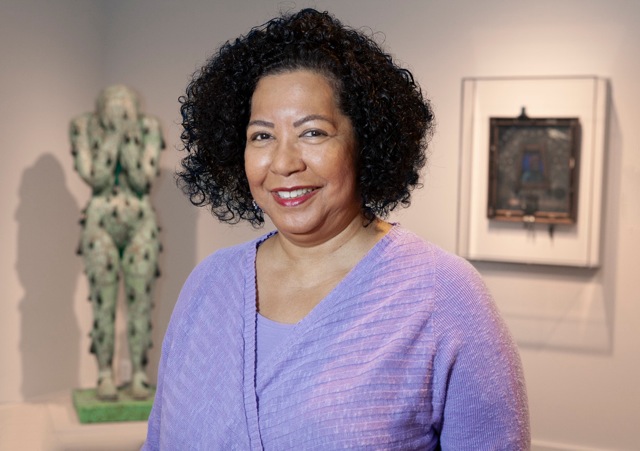
‘30 Americans,’ unique perspectives, on black identity

Triple Portrait of Charles I, Kehinde Wiley, 2007, oil and enamel on canvas. Courtesy of Rubell Family Collection, Miami.
Knight Foundation recently supported the Detroit Institute of Arts to open its latest exhibit, “30 Americans,” free to the public on select weekends, so that it can reached the broadest audience possible. Here, the DIA’s Valerie Mercer writes about the exhibition’s significance.
As the Detroit Institute of Arts’ curator of African American Art, I’ve been excited and proud to work with a team of staff to organize the critically acclaimed “30 Americans” exhibition for our audience. The DIA’s version consists of 55 artworks exemplifying a variety of media: paintings, sculptures, photographs, installations, videos and performance art, all created by African-American artists between 1978 and 2008.
We organized the exhibition around seven themes reflected in the artworks: defying, sampling, freestyling, signifying, confronting, transforming and representing. These themes indicate the varied artistic approaches used by the artists and demonstrate that these practices continue to assert African-Americans’ right to be included in the art world, to reap opportunities afforded all talented artists regardless of race and to courageously challenge the status quo by sharing their distinct and honest perspectives on the world and time in which they live.
The overarching concept that unites the artworks emphasizes the complexities and fluidity of the individual and collective black identity. Racial, gender, sexual, political, and historical identity is explored through a variety of contemporary artistic approaches. While the art was all made before the emergence of the Black Lives Matter movement in 2013 following the acquittal of George Zimmerman in the death of Trayvon Martin, art created by African-Americans has often been inspired by the historical, political and social plight of people of African descent in America since the era of the Civil Rights Movement. African-Americans are keenly aware that no matter how we define ourselves, we are and can be subjected to police brutality, which has occurred in America since the 19th century.

Author Valerie J. Mercer, DIA Curator of the General Motors Center for African American Art.
Several artists in the exhibition came of age at the time of the Civil Rights Movement, including Robert Colescott, Carrie Mae Weems, Kerry James Marshall and Barkley Hendricks. Their art has always focused on black identity through respectively creating images of African-Americans replacing Europeans heroicized in history painting of the past centuries, challenging the objectivity of documentary photography and film regarding black people and their experiences in America, commemorating significant tragic events in modern American history that impacted the fight for civil rights, and showcasing the beauty and style of black culture in everyday life.
Among the younger artists whose art is represented in the exhibition are Kehinde Wiley, Mickalene Thomas, Nina Chanel Abney, Hank Willis Thomas, Gary Simmons, Rashid Johnson and Lorna Simpson. They were influenced by artists of previous generations, parents, new educational and professional opportunities, along with political and social events that affected them and their communities. For many of the artists and, in particular, the African-American public, the Black Lives Matter Movement is not new but an extension of the Civil Rights Movement because the horrors of racism continue to plague our country. Unfortunately, subsequent tragedies in the news remind us that Trayvon Martin was not the first and won’t be the last African-American to die unnecessarily at the hands of someone threatened by encountering a black human being.
My initial hope for the exhibition is that it encourages the public to understand that first and foremost, these artists are among the most important working today, which is why their art has been collected by the prestigious, Miami-based Rubell Family Collection and included in an exhibition. I know several of them and have followed their growing careers for years, so I’m well aware of their commitment to the fine arts profession and long-term perseverance in developing their art. Because African-American art is not included in college and university art history courses, and still scarcely represented in mainstream fine art museums throughout the country, most people are unaware that its origins can be traced back to the early 19th century.
In light of the need for the Black Lives Matter Movement today, I also want the exhibition to inform our audience about the humanity of African Americans and that the history emphasized in these artworks is not solely African-American but wholly American, and should be known by all. The skill and talent revealed in the artworks are impressive, although the historical truths expressed in each object’s content can be unsettling for some. However, just because the facts are disturbing is not a good reason to keep avoiding them. The exhibition should provoke those long-awaited conversations about race, especially between whites and blacks, that we keep hearing need to happen. These conversations are way overdue and it’s frightening to consider what will happen next if the need for them continues to be ignored.
The exhibit “30 Americans” runs Oct. 18, 2015 – Jan. 18, 2016 at the Detroit Institute of Arts. The public can enter free on opening and closing day and the first Saturday and Sunday in November, December and January, with support from Knight and Ford Foundations.
Recent Content
-
Artsarticle ·
-
Artsarticle ·
-
Artsarticle ·
